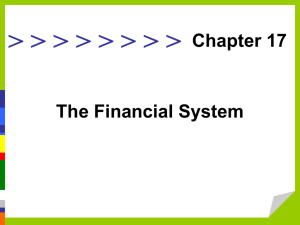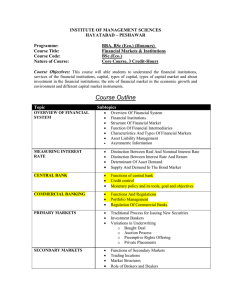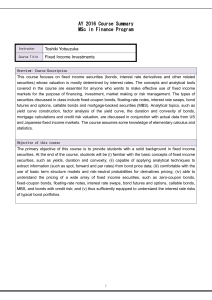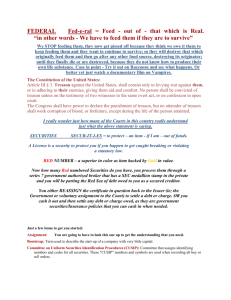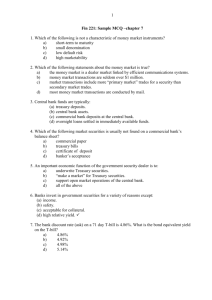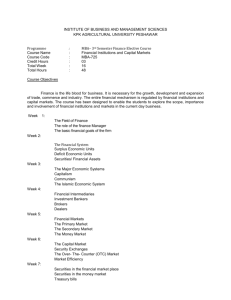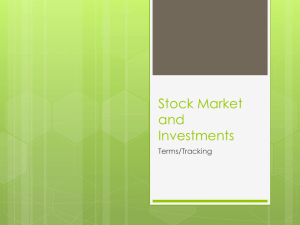NYSE
advertisement
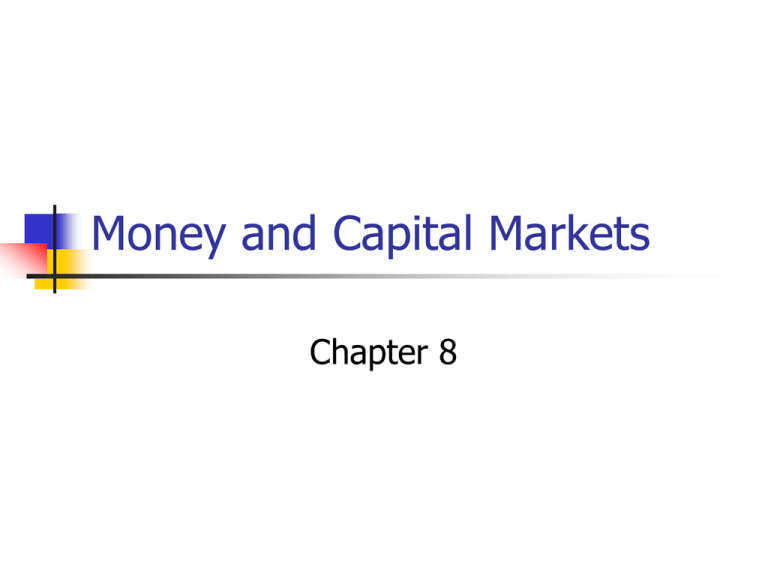
Money and Capital Markets Chapter 8 Introduction Market for U.S. government securities is the center of the money and capital markets U.S. Treasury has to sell many hundred billion dollars worth of securities each year to pay off maturing issues and finance current government operations Provides reference point for money market (debt less than one year) and capital markets (long-term debt/equities) The Government Bond Market When U.S. government runs a deficit, the Treasury Department borrows money by selling government bonds Sell to anyone willing to lend money to U.S. government Treasury issues a wide variety of maturities and types of government securities The Government Bond Market U.S. securities are basically two types Marketable [63%]--bought/sold in financial markets Nonmarketable [37%]--sell back to Treasury U. S. Treasury Securities Treasury Bills (T-bills) Treasury Notes (T-notes) most liquid issued each week on a discount basis maturities of 13, 26, 52 weeks original maturities of 2, 3, 5, 7, 10 years coupon issues – semiannual payments Treasury Bonds maturities of 10 to 30 years. Similar to Notes. Strips Dealers market the coupons and the body of the security separately as zerocoupon securities. Stripped Treasury Securities TIGRs - 1982 Merrill Lynch CATS - 1982 Salomon Brothers STRIPS - 1985 Inflation-Indexed Treasury Bonds 1996, Treasury announced that it would periodically issue inflation-indexed bonds that would provide returns tied to the inflation rate. Coupon is low Principal increases by the amount of the inflation rate every six months. Owners of Marketable Government Securities Federal Reserve Purchases Open Market Operations—mostly Tbills Provides Fed with most of its income Private Sector Commercial banks Individuals Insurance companies/Pension Funds Money market mutual funds Owners - continued Foreigners Now own about 37% of U.S. national debt Without foreign purchases, U.S. interest rates would be much higher Foreigners are attracted to U.S. securities: Political stability Financial freedom—Dollar is easily traded Relative high interest rates U. S. Treasuries Sold through auctions (first-price, sealed-bid auction) Registered and issued in book entry form Default-free Highly liquid Interest income exempt from state taxation Treasury Bills Sold on a bank discount basis. Yield on a discount basis—Calculated as face value minus purchase price divided by the face value Bond equivalent yield or coupon equivalent yield. More accurate measure since it uses purchase price rather than face value Bid and Offer Quotes on Treasury Bills 3 month Jan 18 ‘96 Maturity 93 Bid Ask Yield 5.27 5.25 5.41 Bank Discount Basis The quoted yield on a bank discount basis is not a meaningful measure for 2 reasons: based on face value rather than actual dollar amount invested. annualized according to a 360-day rather than a 365-day year - making it difficult to compare Tbills with treasury notes and bonds which pay interest on a 365 day basis. Computing Yields on Treasury Bills BANK DISCOUNT BASIS: F P 360 yD F T where yD = discount yield, F = Face value ($100), P = Price, T = the number of days to maturity, and 360 is the number of days in the year. Computing Yields on Treasury Bills Coupon equivalent yield: yBEY F P 365 P T where yBEY = coupon equivalent yield, F = Face value ($100), P = Price, T = the number of days to maturity, and 365 is the number of days in the year. Computing Yields on Treasury Bills Examples based on the March 30, 1998 T-bill Auction: P (26 week T-bill) = 97.434 yD = 5.075 percent T = 182 days YIELD ON A BANK DISCOUNT BASIS: 100 97.434 360 yD 0.050756 100 182 COUPON EQUIVALENT: y BEY 100 97.434 365 0.05282 97.434 182 How the Market Works Most trading takes place in over-the counter markets Trading in government securities averages more than 20 times trading on the New York Stock Exchange Increasingly traded around the clock in different parts of the world How the Market Works Dealers get much of their inventory of bonds by bidding at competitive auctions Three- and six-month T-Bills are auctioned weekly Notes are auctioned on a regular scheduled basis The Treasury issues new securities to Raise new funds Replace funds of maturing securities T-Bill Auction The treasury allocates bills to competitive bidders from the low-yield bid to the highyield bid until the amount of the auction minus the non competitive bids is distributed. Noncompetitive bidders pay the weighted average price of the competitive bids accepted. Stop yield - highest yield accepted by the Treasury. Auctions At closing time of auction Treasury does following: Ranks bids from highest price down Selects bids in this order until amount sold equals amount scheduled to be sold Therefore, successful bidders purchase bills at different prices and will earn different yields Auctions Multiple-price, sealed-bid auction Bidders pay what they bid. Provides incentives for bidders to acquire more information than is socially desirable. Bidders want to balance the gain from a lower winning bid against the risk of not winning. English Auction Uniform-price, sealed-bid auction Price paid by a winning bidder does not depend on that bidder’s bid. Dutch Auction. Salomon Brothers Scandal 1990 Treasury bond auction Bought 65% of an auction – exceeding the 35% maximum Other dealers that had made commitments that they were unable to fill had to obtain bonds from SB. SB could charge high prices since they controlled most of the bonds. August 1991, the Treasury Department barred SB from bidding on Treasury securities for clients. May 1992, SB paid fines of $190 million to the SEC and Justice Department. Changes in Procedure Electronic Bidding Noncompetitive bids are accepted electronically over Fedline, 1992. Fedline - a general communications system that links 9,000 depository institutions with the Federal Reserve Banks. Dutch Auctions September 1992, experimented with a Dutch Auction on two- and five-year bonds. All successful bidders pay the price of the lowest accepted bid. (Second-price, sealed-bid auction). Discontinued because of unpopularity with dealers. Security Dealers’ Profits •Bid-Ask Spread •Capital Gains or Losses •Coupon Payments Bid-Ask Spread • The ask price is what the dealer will sell the security • The bid price is what the dealer is willing to buy the security for. • The spread represents profit. Coupon payments • The interest that the dealer earns on securities held in its inventory. • The difference between the coupon return (rate) and the cost of borrowing (rate) is called the “carry” for the security. • Dealers borrow funds from banks and through the market for repurchase agreements by borrowing on securities in inventory. Market for Repurchase Agreements a.k.a., the REPO Market •A repurchase agreement is the sale of a security with the commitment by the seller to repurchase the security at an agreed upon future date, the maturity of the repo. A repo is then a way of borrowing funds using a security as collateral. •A reverse-repo is the purchase of a security with an agreement to resell the security to the original seller. A reverse-repo is a way of investing funds with the security as collateral. •The market is used by dealers for funding and the Fed to carry out Open Market transactions for monetary policy. Repurchase Agreements (Repos) A dealer needs to finance $10 million of a Treasury security that is purchased and plans to hold overnight. A customer of the dealer has excess funds of $10 million. The customer might be a municipality with tax receipts that it has just collected, and no immediate need to disburse the funds. Repurchase Agreements Enhance the liquidity of the government securities market. Although collateral is provided, still have credit risk. Must monitor value of collateral. Physical delivery of securities to a custodian is the safest way to take collateral. Bank-Related Securities CDs Large CDs $100,000 Negotiable Eurodollars Dollar-denominated time deposits LIBOR – London Interbank Offered Rate Overnight rate for Eurodollar lending Tends to follow U.S. rates Corporate Debt Securities Corporate bonds are not risk free. Some have security, some are subordinated to other debtor claims, and some have conversion and call features. Commercial Paper Corporate Bonds Corporations borrow across all maturity ranges—mainly at the long end High-quality corporate bonds usually yield more than government bonds and are safer than corporate stocks Bonds have prior claim before stocks— payment of interest is first priority Being long term, these bonds are subject to interest-rate risk—interest rises, prices fall Corporate Bond Features Callable bonds Issuer has right to pay off the bond before maturity date Bond option will be exercised if it is in the interest of the borrower These carry higher interest rate Convertible bonds—holders have right to convert to common stock at predetermined price Corporate Bond Ratings Corporate bonds differ in quality— danger of default by borrower U.S. government is safest Various bond rating agencies Standard and Poors Moodys Investment grade—highest quality bonds Corporate Junk Bonds Junk bonds Very risky, but pay high interest to compensate for risk Tend to perform well when the economy is strong, but extremely risky when economy does poorly Michael Milken [convicted of securities fraud] and Drexel, Burnham Lambert [bankrupt in 1990] are two examples of problems in the junk bond market Purchasers of Corporate Bonds Life insurance and pension/retirement funds hold most corporate bonds Schedule cash flow based on life expectancies Hold to maturity—little need for quick liquidation Foreigners also hold large amount of corporate bonds Generally traded in over-the-counter market— usually by telephone Commercial Paper Unsecured short-term IOU issued by a corporation. Maximum maturity of 270 days. May be interest bearing or discounted. Can be issued directly or through dealers. May be rated. Unrated paper is issued at substantially higher yields. Commercial Paper Two categories of issuers: Finance companies associated with well known manufacturing companies Nonfinancial companies--generally to finance inventory Usually purchased directly from issuer by large institutional investors Commercial Paper Because of possibility of default, yields are typically higher than Treasury Bills, but tend to move closely together Not much of a secondary market— investors generally redeem with issuer GE Capital Corporation Largest and most active direct issuer in the US. Commercial paper outstanding in excess of $70 billion. www.gecapital.com Municipal Securities Issued by state and local governments Lowest yield because interest earnings are exempt from federal tax By law Congress does have the power to tax, but has decided not to tax this source of revenue Municipal Securities General Obligation Bonds Revenue Bonds Short-term General Obligation bonds are safer and generally pay less interest than Revenue bonds. tax-anticipation notes (TANs) bond-anticipation notes (BANs) Not much of a secondary market Municipal Securities “Serial” maturity form Portion of the issue matures each year until entire issue is retired Each portion carries its own interest rate and is separate from the rest of the issue In essence a 10 year serial bond is really 10 separate issues, each maturing at different times Sold through underwriting syndicates who sell to ultimate investors at slightly higher prices Mortgage Securities Most complicated of all debt instruments Borrowing by individuals using real estate as collateral Most mortgages are insured by some type of government agency minimizing potential default of borrowers Governmental National Mortgage Association Federal Home Loan Mortgage Corporation Mortgage Securities Mortgages can be repaid prior to maturity date Prepayment or refinancing due to lower rates Investors are not sure of maturity Investments undesirable to institutional investors Innovations in mortgage terms Shorter maturity period Adjustable rate—minimizes interest rate risk of lender Balloon payments—low front end with large lump sum payment at end Collateralized Mortgage Obligations (CMOs) Developed to reduce uncertainty and broaden the appeal of mortgages Number of mortgages are placed in a trust Interest and principal repayments are divided by trustee into four (or more) segments according to a predetermined formula Investors select which segment from which to receive their payments Makes the cash flow more predictable High yields = High risk The Stock Market Structure of the Stock Market About 84 million individual shareholders in U.S. During past decade institutional investors (pension funds, mutual funds, and insurance) have begun to dominate the market Stock Market—refers principally to secondary market for common stock Primary issues are handled through investment banks Stock (Equity) Exchanges Stock exchanges: Organized marketplaces for corporate equities and bonds. Over-the-counter (OTC) stocks: Equity shares offered by companies that do not meet listing requirements for major stock exchanges, or choose not to be listed there, and instead are traded in decentralized markets. Stock (Equity) Exchanges New York Stock Exchange (NYSE) The oldest (1792) and largest exchange where roughly half of the stock trading in the United States is done. Shares of more than 3,000 companies are traded there. The number of NYSE membership positions, called “seats,” is fixed. National Association of Securities Dealers Automated Quotation (Nasdaq): The electronic network over which most over-the-counter stocks are traded. Structure of the NYSE Posts—location where individual stocks are traded Traders—receive orders from brokerage houses Specialists—individuals who maintain orderly trading for securities in their charge May just match publicly tendered buy and sell orders Floor traders stand at posts and compete for orders not matched by specialists If neither of these occur, specialists will buy or sell for their own account to prevent excessive price swings Order Flow On floor-based markets, specialists function primarily to match buy orders with sell orders throughout the trading day. This model works best in a balancedvolume situation, one is which buy and sell orders are relatively equal. On particularly heavy trading days, keeping up with the flow of transactions can be a challenge for the single specialist, who may request that the market temporarily halt trading in a stock if order imbalances occur. Structure of the OTC Market Network of dealers and brokers who deal via telephone and computer terminals National Association of Securities Dealers Automated Quotation System [NASDAQ]—Shows bid and asked prices of OTC traded securities NASDAQ Structure of multiple market participants. Multiple market participants trade a company’s stock through a sophisticated computer and telecommunications network. These participants are divided into two groups: Market Makers Electronic communications networks (ECNs) trading systems which bring additional customer orders into Nasdaq. Market Makers Market Makers are independent dealers that compete for investor orders by displaying their buy and sell interest - plus customer limit orders - in Nasdaq-listed stocks. Market Makers increase the visibility of shares through their combined sponsorship. By standing committed to buy and sell shares of a company’s stock, Market Makers help meet investor demand and create an environment of immediate and continuous trading of a stock. Order Flow on the NASDAQ Each Market Maker competes for order flow by displaying bid (buy) and ask (sell) quotations on screen. When an order is received, the Market Maker will immediately purchase for or sell from his or her own trading account, or seek the other side of the trade until it is executed, often in a matter of seconds. Because Nasdaq distributes trading in a stock among multiple market participants, fluctuations in volume can quickly be absorbed - even on particularly heavy trading days. No halts for order imbalances may occur on Nasdaq. Secondary Market Trading Electronic Communications Networks provide trading in NASDAQ securities The Island allows the public to view the “order book” in real time. What determines whether stock prices rise or fall? Stocks (equities) represent ownership company Investor receives future cash flows in form of dividends In its simplest form the price of a stock with constant dividends forever is: Pr ice Expected Annual Dividend Annual Rate of Discount Stock prices continued Therefore, the price will rise if: Expected future dividends increases Annual rate of discount decreases The discount rate is higher than the government bond rate to compensate for the risk of stocks However, the discount rate will follow movements in the government bond rate Stock prices continued Therefore, price of stocks move in same direction of earnings and inversely with interest rates To predict movements of stock prices must predict: Expected future earnings Expected future interest rates This requires knowledge of future movements of the entire economy Money and Stock Prices Some economists believe that fluctuations in the money supply will provide key to movements in stock prices Increase in money supply will increase stock price: Individuals hold larger cash that they need Spend some on stock which increases demand and increases price (assume supply fixed in shortrun) Opposite for a decrease in money supply Money and Stock Prices Therefore, rapidly expanding money supply generally leads to higher stock prices; inadequate growth of money leads to a fall Difficult to determine if stock and money growth are related to each other or reacting to a third causal force However, other economic forces may cause stock prices and growth of money supply to move in opposite directions

